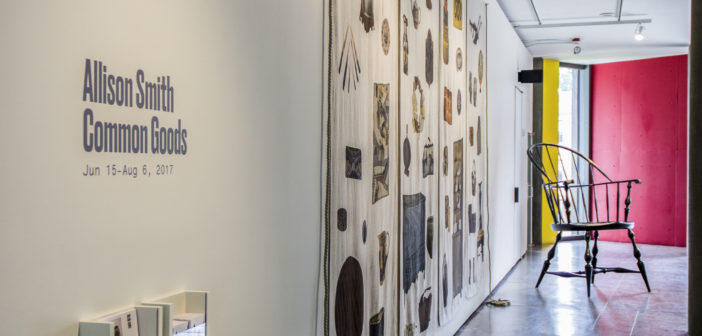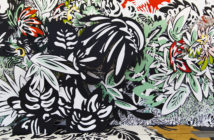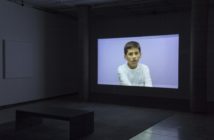On September 16th, visitors to Cambridge Common Park may do a double take when they encounter a large black Windsor chair in the midst of the numerous war memorials and monuments. Curious passersby may sit with a friend or stranger on the playful chair that is enlarged to seat two. The work is by artist Allison Smith and part of the Common Exchange public art program curated by Dina Deitsch. The summer-long program seeks to create a sense of shared civic space through performances and temporary works that explore concepts of pathways and connectivity. Deitsch invited Smith because of her connection to American revolutionary history and her participatory works that combine craft and performance. The Windsor chair will only be taken out to the Cambridge Common for special events, but it can be seen through August 7th at the Carpenter Center for the Visual Arts alongside linen wall-hangings by Smith that display images culled from her collection of photographs of colonial-era objects and colonial-inspired craft. I talked with Allison Smith about her work for the Cambridge Common, her CCVA exhibition, and her larger body of work that mines objects from the past to see how they can speak to the present. --Joshua Fischer
Joshua Fischer (JF): When you got this opportunity, how did you decide on the chair?
Allison Smith (AS): When I came in 2014 for the Josep Lluis Sert Practitioner in the Arts residency at the Carpenter Center for the Visual Arts, I spent a week visiting different craftspeople in the region. One was The Old Schwamb Mill, one of the longest running wood mills in the country. Everything is operated by these amazing leather straps, and they make these turned wood oval and circular frames. We also visited Hallie Larkin and Steph Smith, proprietors a business called At the Sign of the Golden Scissors, who make colonial era costumes for revolutionary war reenactments and living history events. I was really interested in this idea of people who are actively working in an early American historic craft tradition. I have a long history of doing projects of engaging those people in a conversation about what they make, why they make it, what drives their impulse to make it and thinking about those kinds of craft traditions as a sort of performance. My work is a critique of Living History culture and open air living history museums in which nationalism is performed, as well as other kinds of identity, whiteness, and masculinity. So in a lot of my projects, I take some of the aesthetic and performative qualities of reenactment culture but steer them toward different ends.
Between the Sert residency and this opportunity, a couple of other things happened. James Voorhies, the former Director of the Carpenter Center, organized a show called The Way We Live Now: Modernist Ideologies at Work in 2015. I had some work in that show. At that time I was doing a residency called the Artists Experiment initiative at the Museum of Modern Art in New York where I was researching the Rockefeller family and their development of both the Museum of Modern Art and Colonial Williamsburg simultaneously. This project was happening in the 1930s by the same small group of people trying to forge what they hoped would be considered this kind of essentialist, North American aesthetic language that was looking both backward and forward at the same time. Few people even know about that or ever put those things together. I was really interested in the idea that modern art and colonial craft actually have something in common as part of a nationalist project. They were absolutely entwined, and that is something you can trace to a few people and their intentions. So that's a reason why it makes sense to have these kinds of objects in a space like this [Le Corbusier’s Carpenter Center], which is so emblematic of modernist, utopian architecture, and it is also a school where pedagogy is embedded in the building itself.
I was approached by Dina, and we had been talking for many years about different kinds of public projects. I have done many things that are in public and that are participatory, but very few things that are permanent public artworks or things suited for outdoor space, so this was another kind of challenge. How do you create something that is inherently temporary, that may be ephemeral, but that you want to have some kind of sticking power, something that isn't so imposing on the space that people are like 'why is this here?' There's already a huge civil war monument that towers over everything and other strange things, like canons.
So why add another kind of monument or monumental piece? How can you engage with people who are really just going from point A to point B in a way that is not annoying or inappropriate. So how do you do that? How do you create a quality interaction that's either not too imposing or not so ephemeral that it could just get lost in the fray of a busy intersection?
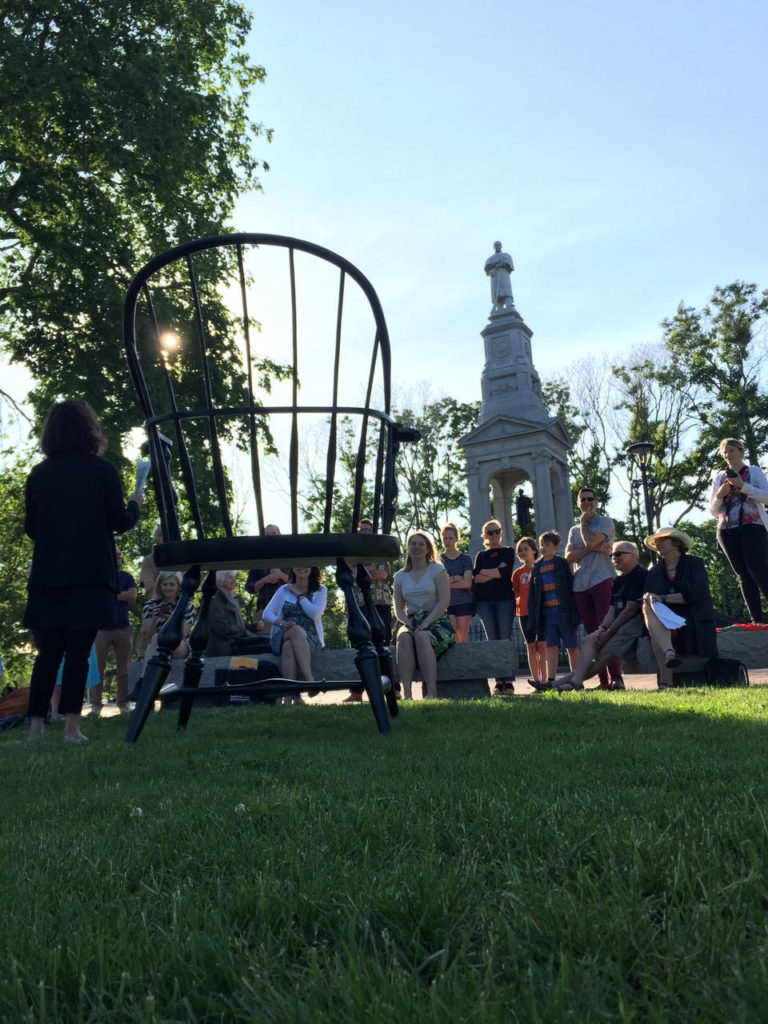
Common Exchange workshop in Cambridge Common, June 15, 2017, Photo: P.T. Sullivan
I was also really interested in the North Bennet Street School in Boston. I had always known about it as a place you could study traditional, early American furniture making. It is a parallel art world of people invested in the history of making and materials, but coming from a completely different set of impulses and politics. In the meantime, I had been in Sweden looking at the development of the slöjd movement, the educational handcraft movement there, and found that there was a connection in the philosophy of that movement to the North Bennett Street School. So then came the idea to actually commission someone who both studied there and teaches there to make something. I came up with the idea of a Windsor chair that would be large enough to seat two people and where an intimate conversation could potentially take place. I have done other projects with thousands of participants, and I have found that it doesn't always need to be that much of a spectacle to have a really engaging experience. What if we just set the ambition to things that can happen between two people at a time?
Eli Cleveland is the maker of this chair. It is double-sized, and he made it according to very traditional, strict standards of furniture making. For example, traditionally these chairs are made of three different types of wood -- this one was made of hard maple, eastern white pine, red and white oak -- depending on the part of the chair and its function. He completely embraced the project, doing it very historically accurately, except for the idea of enlarged scale. I also liked the idea of the armchair being something that could wrap its arms around the sitters. It embraces you. In general, I have used the large scale format in a lot of my projects to draw a viewer or participant into a project. There's something kind of disarming about it. The big chair must be a public art trope. I knew people would want to take selfies with it. The chair could also come out into the commons and come back, move into and out of public space at different moments. It didn't have to live outside and could have multiple lives.
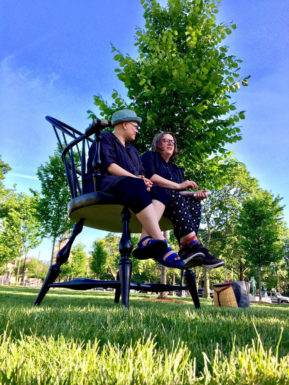
Judith Leemann (left) and Allison Smith (right) at Common Exchange workshop in Cambridge Common, June 15, 2017, Photo: P.T. Sullivan
JF: In a lot of your work, you've been interested in creating a platform for something to happen. Do you have any expectations for what might happen on this platform? You mentioned people would take selfies.
AS: I will occupy the chair with Judith Leeman on June 15th. She's an artist, and we will be leading a conversation. Judith and Kenneth Bailey, who’s an activist, will be taking up the seat on Saturday, June 17th, and then there will be more conversations to come.
As far as a specific expectation, I have learned to modify my expectations within any kind of public practice. Coming from some other place and arriving in a location you can't really assume how people will respond or interpret or participate or not. There's so much that is completely out of your control. What I try to focus on is framing the possibility of an exchange. I don't always have access to what that exchange is or how that plays out, but I take responsibility for the chair and the backdrop.
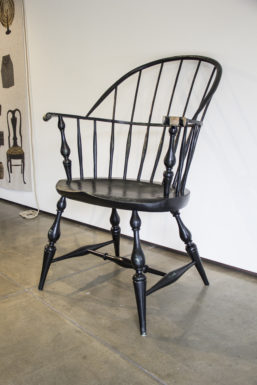
Installation view, Allison Smith: Common Goods, Jun 15 – Aug 6, 2017. Courtesy Carpenter Center for the Visual Arts, Harvard University.
JF: I do not know much about the history of the Windsor chair and whether as a craft object it was considered particularly humble at one point. Is it an example of colonial craft that was devalued or has it always held a certain kind of prestige? Also, a lot of your previous work has had a dialogue between war and craft. So many of the monuments are commemorating military events, and this is a domestic object that has no obvious relationship to that. Did this enter your thinking?
AS: My understanding of the Windsor chair is that it is a middle class object. It originated in Great Britain, came to the United States, and it quickly became a ubiquitous form. You might see these chairs in paintings of events happening at state houses and also in common everyday scenes. As far as I am aware, it covers this spectrum. It is not humble or aristocratic. I chose it because I am interested in the ways in which everyday objects or functional objects of the past become almost emblematic of national identity. This is one of those things that I see in that canon of American objects even though it's not originally American. I think it originally came from people who were making wheels, like wheelwrights. You see the spindles on the back, for example. This particular chair is called a sack-back Windsor chair because it takes its name from the sack-like covering that used to be placed on the back of it to prevent drafts from passing through it.
To your question about monumentalizing a piece of furniture in a park with other war memorials, you could read it in contrast to things like equestrian statues, even though there’s not one of those in the park but there are figures. The idea of making the participant the live figure is the essential idea that I would like to get across which is that maybe the best kind of memorial is one that is a living conversation, rather than trying to come up with permanent forms to symbolize an event or a victory or a loss. The most important thing we can do is have communication that is ongoing.
JF: That's really interesting because at this moment there is so much conversation about memorials like the Confederate monuments in New Orleans and debate on college campuses about naming and whether statues should be taken down. Do you see this gesture fitting into that current conversation?
AS: I have definitely been aware of those conversations too. I grew up in Virginia, and I have a long history of looking at the culture of civil war reenactment with the Confederate flag and things like that. Other projects I have done are more intentionally meant to be a response to the idea of war memorial statuary. I made a performative sculpture that was a large hobby horse that I rode at ArtPace in San Antonio, which was a response to equestrian war memorials. Another project I did in Indianapolis was a parade project. I made a series of large-scale pull toys, a donkey, a jackass, and a mule, and that was also a response to war memorials. In other projects, I have had a long interest in objects that soldiers make in the context of battle, in prisoner of war camps, and in hospitals. I think of that as an ultimate war memorial that's actually coming from people with direct experience of armed conflict. Craft has historically been used to bridge civilian and military populations and used as part of the healing process, then and now.
At the same time, I look at historical reenactment as a kind of memorial, but an active, performative process that is not really inclusive enough. It presents itself as a way of preserving the past in this very heightened way and also teaching about the past, but it is also inevitably about entertainment and spectacle. From a certain perspective, it is necessary in response to old style war memorials because they don't get activated. They tend to just recede into the landscape in a way, even though they are ubiquitous and imposing in another way.
Regarding the idea of monumentalizing the chair, maybe it is a memorial to craft or to the idea of what is happening in the chair itself, the discussions that happen in and around and through the chair, whether it’s the making or the sitting and ensuing conversations. There's also some humor to it, I think.
JF: There's a lot of humor because it dwarfs whoever sits in it. You're not going to get up there with a straight face. What decisions did you make about how it is designed, like the way the handles are worn?
AS: When we commissioned Eli to make the chair, I did look at examples of Windsor chairs, and there are a lot of different variables. One of the things I asked for was something that would be true to these early American examples, but that's kind of a contradiction because there were a lot of variations. Part of it had to do with what I responded to visually. There were also some interesting namings of different parts of the chair that I liked. For instance, the handles or handholds were referred to as knuckle handholds, and I really liked that idea because it suggests the arms coming around the sitter or sitters, ending in fists.
I was interested in the traditional way that they are made. The spindles are hand riven and all of the legs are turned on a lathe. There's steam bending and there's carving. I didn't want any shortcutting with power tools. In terms of the wearing of the knuckles, that was a decision Eli made based on how the old chairs were originally all painted green. At some point they started painting them black, and they are almost always black now. He was really interested in showing that by first painting the chair green and then black and then having some areas that are worn down so you can see that history, which I thought was great.
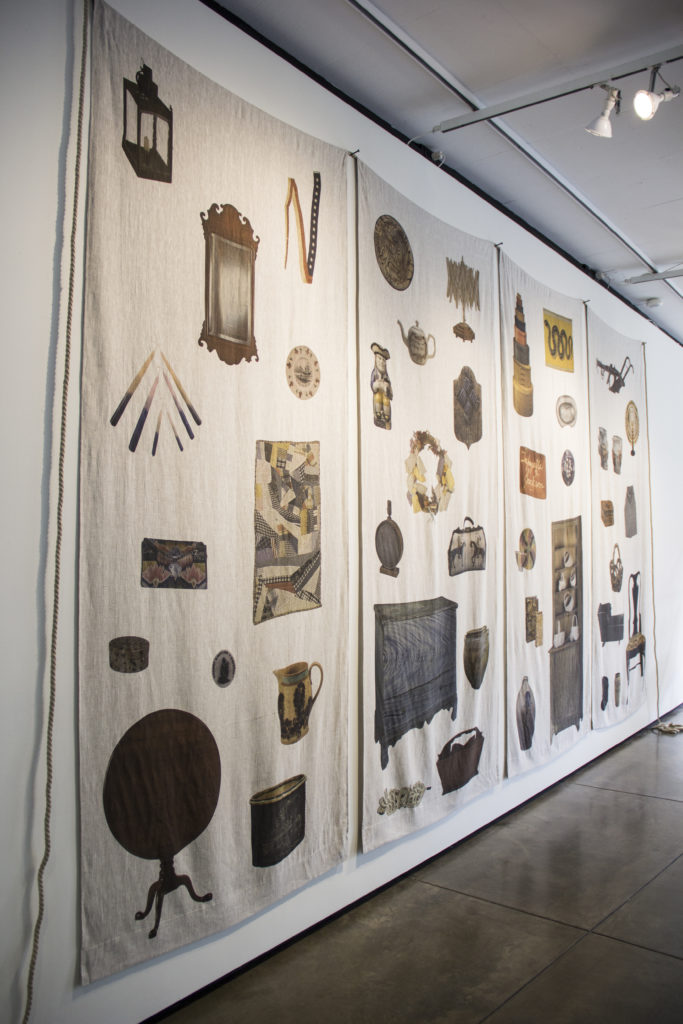
Detail, Allison Smith: Common Goods, June 15 – Aug 6, 2017. Courtesy Carpenter Center for the Visual Arts, Harvard University.
JF: Could you talk about the linen wall-hanging with the photographic images in The Carpenter Center. How does that relate to the chair?
AS: This space is the satellite location where the chair lives when it’s not being activated [on Cambridge Common]. I was really interested in this space [at The Carpenter Center]as a stage set and a vitrine. I immediately thought of doing a backdrop for the chair, which might suggest a photoshoot where you can sit in the chair. Also, it related to domestic curtains with a repeated pattern.
As for the imagery on these printed linen curtains, I drew from my personal picture collection which is quite large. I really enjoy collecting pictures from auction catalogues and vintage books and magazines and home decorating magazines. A lot of the objects seen here are historic early American objects, and then other things are anachronistic or more contemporary. I like the fact that you can't always tell which is which. I am working on a key for these objects, but I am not using any dates. It is a very subjective set of footnotes.
It's almost like a rebus, a lexicon, an atlas, or an index of images. I am also interested in connections between early American and pre-modern psychedelic abstraction. I am really interested in moments of psychedelic abstraction that appear in everyday objects of the 1700s and the 1800s. This comes from a period known as “American Fancy,” which inspired the Fancy Work project I did and is considered an original American design movement in the late 1700s that involved a lot of abstract swirling with really colorful patterns in furniture, ceramics, textiles, lighting, flooring, and wall decoration. For example, sconces were kind of like an inverted disco ball. They scattered light across the room. This type of flame-stitch embroidery would appear on things like pocketbooks. These were men's wallets. This one has a carnation pattern.
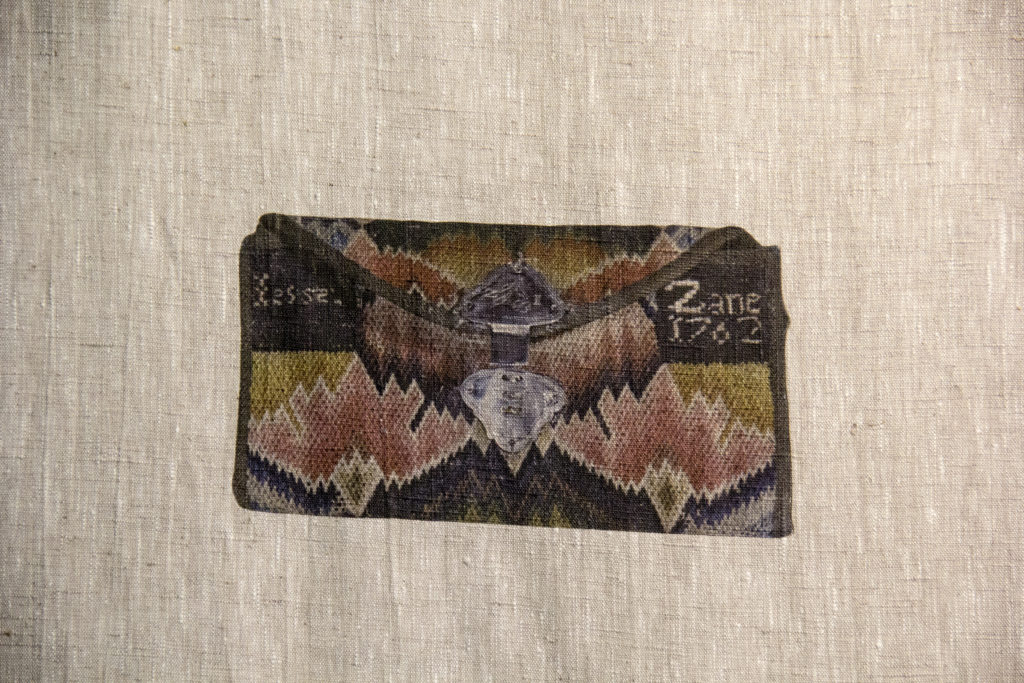
Detail, Allison Smith: Common Goods, Jun 15 – Aug 6, 2017. Courtesy Carpenter Center for the Visual Arts, Harvard University.
JF: You are obviously applying the term “psychedelic” retroactively to it. How were these things regarded at the time?
AS: There's a great book called American Fancy: Exuberance in the Arts by Sumpter Priddy III, an American decorative arts historian. He theorizes that a lot of this came about during the time of the invention of the kaleidoscope. People were completely amazed by kaleidoscopes, so these faceted patterns in quilts and patterns in flooring and everyday objects reflect that. He theorizes that it speaks of the moment, but also it contradicts this idea of a staid, conservative neo-classical style. When we think back to colonial style there's a certain palette, an austereness, and his research really contradicts that. The first time early Americans tried to assert their own aesthetic preferences it was actually very colorful, very gaudy, very loud, very chaotic, very psychedelic.
I am interested in any moment in which an aesthetic intention is coupled with the development of self or nation. Here's a moment that was theorized as this defining moment in early North American visual aesthetics, so I'm fascinated by that. There's definitely too a subversive, maybe a feminist pleasure in the idea of lifting up or identifying these moments of abstract art that come out of a humble or domestic, non-hierarchal impulse. There are a lot of alternative modernisms. This is what I think of as an alternate modernism that captures my fascination.
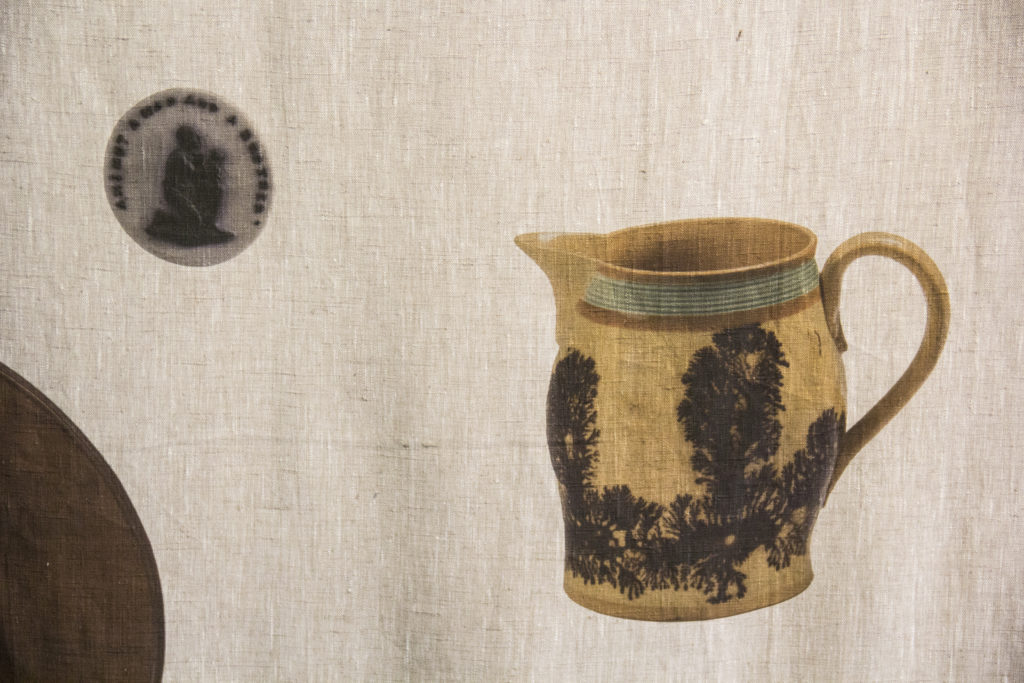
Detail, Allison Smith: Common Goods, Jun 15 – Aug 6, 2017. Courtesy Carpenter Center for the Visual Arts, Harvard University.
JF: You used an interesting term, "lifting something up," not to elevate, but to mess with it.
AS: I think that's a great way to put it -- "messing with things" -- because I do think that certain things need to be held up and brought out into view, but it is for the purpose of conversation. It's not that I'm saying all of these are good things that have been forgotten. I don't think that ultimately the craftsman or the individual maker is ever really innocent. I think of it more as if we are all constantly participating in the processes of identity formation and the inclusive, exclusive defining of who "we are" through what we make. In material culture studies there’s this notion of a reciprocal process, that objects make us as much as we make them. They're also receivers and transmitters.
It's not that I want to glorify all of these things. It would be more important for me to combine things in a subversive way or in a disturbing way or in a funny way. You referred to this use of a platform. I do like to throw up this stuff and let the chips fall or let the conversation happen. I could do a whole project about any one of these things and go deeper and deeper, and each of these things has the potential for a conversation that might be underestimated.
JF: As an artist you've been doing this research work combined with an interest in objects, making, and social practice or participatory pieces. I think it is really interesting how you've kept those things in balance. I find that sometimes certain work will tip one way or another.
AS: I do try to keep those things in balance somehow. I really enjoy research. To me, it's one of the most enjoyable parts of being an artist, and yet I also am, as are many artists, very subjective and eccentric in my research practices. That’s how the picture collection started: a voracious gathering of stuff and gravitation to strange or forgotten histories that I want to dig into further.
As much as I think of myself as a conceptual and research-based artist, I also love making things. I am quite happy to be in the studio and learning from others how to make stuff. Apprenticing myself to someone to learn how they make what they make is also part of the learning, research, and pleasure.
As far as bringing together fields like traditional craft and social practice, I came to craft through looking at reenactment culture and the way meticulous handcraft is utilized in that context. My work has evolved through these burgeoning conversations about social practice, craftivism, and DIY craft. When I started making this work, those were not active conversations. It was rarer to think about bringing craft to a participatory mode only because with a lot of socially engaged art there's a real suspicion of the object because it participates in capitalism and the gallery system. The object is foregone in lieu of a more direct conversation. It’s like, get this object out of the way, let's just talk. Let's just do direct action.
In the world of craft there's an equally strong impulse toward engagement and connection, but it is through the object. The object is absolutely essential. It's through that hand to hand, “I made this” connection. All of the history of craft is rich with collaboration and dialogue, and with so many different craft practices you have to work collaboratively to get the work done. You cannot really work alone even though in both art and craft we have these ideas about the individual toiling away. Whether that's the artistic genius or the hardworking craftsman, these are both very collaborative processes. I've always been really interested in the way that objects, rather than being these dead artifacts, they speak about and refer to worlds of conversation and events happening around and through them in their making. I've always wanted to activate that in objects.
I think of myself as a sculptor, but the sculptures are always more interesting when there's something happening. I think that's because I want my sculptures to have the same kind of artifact quality that I love so much in objects like these [on the linen wall-hanging]that witnessed something and were produced by a larger social context even if a lot of that information is lost to history. I think that's also why for me the Windsor chair is not as interesting as a sculpture as it is a platform for these conversations. Even the potential of that is much more interesting for me than making a sculpture of a chair.
JF: Are all of these things pictured here things you’ve experienced or pulled off the Internet? I ask this because there's interest right now in digital collections, and how images circulate now so freely. Usually they lose a lot of context, and they are free floating.
AS: I love the term free floating for this because they are all free-floating signifiers, free floating objects. I was thinking about this idea of Google image search in the way they are laid out, roughly spaced in a grid. However, there’s no image here that is specifically taken from the Internet. Some of these things are extremely rare and valuable even though I'm referring to them as common goods, and some of them are much more ubiquitous.
JF: I love the way you use language to have double meanings in your titles like Stockpile to refer to stockpiling of goods as well as armaments. Could you talk about the title, Common Goods, and how you came up with that?
AS: The invitation to be part of this Common Exchange project is all about the commons as a utopian ideal and space for communication exchange, and the Cambridge Common as a literal site for things like gathering of the troops and protest which have infused it with intensity. The word common also means generic and plain. It's just so common, it's ubiquitous. Originally I had this idea to recreate the [CCVA] as a “Carpenter's” Center for the Visual Arts. It didn't happen, but I did get to work with a carpenter. I like this notion of the common carpenter, common everyday things, things we have in common, and this idea of common goods came up because I was thinking about objects.
I also think a lot of the aspirations of socially engaged work have to do with creating something that would be for the common good, and I have been having a lot of interesting conversations about this notion of social practice as a form of public service and the questions and problems around that. On the other hand, there's not a general appreciation of the arts for the common good in the United States. The NEA is not really supported. The arts are really not a part of everyday life in the way that they are in other places. So the idea that public funds should not go to fund art speaks to the notion of a lack of appreciation for the power of art and the value of art. I wanted to talk about those things as potential conversation points in the chair.
There's the Grant Kester book, Conversation Pieces and the historical term "conversation piece." I think of that as not a small thing, but something that has a lot of potential because conversation is so valuable. Public debate and dialogue is so important and obviously now more than ever. If I was really only interested in these objects, it would seem quite tangential to what is actually going on. It's more of a strategy whereby maybe a curious object could just get the conversation going, which I think all art strives to do in a way.
JF: There’s also historically been a lot of debate and activism about finding one singular common good, one issue that everyone would rally around. You are complicating that with this idea of multiple common goods.
AS: Right, exactly. I like that idea of the common good as something that needs to be inherently plural and multiplicitous. You could say that true political art is only political when it has a goal and attempts to address that goal and it’s successful if it does that or not. I think that my work is not really political in that sense because I am ultimately more interested in that complex dialogue. I was a student of artists coming out of institutional critique, strategies where it is important to identify the enemy, so to speak. In my own work, I think of it as a risk. I've taken the risk of being potentially perceived as embodying the conservative politics that I want to critique because I'm much more interested in a conversation that would not just be preaching to the choir, but could engage people who come to it with really different politics from hopefully a wide spectrum of backgrounds.
Going back to social practice or socially engaged art, there's a lot of people who would think of my work as being too aesthetic, but to me it's not possible to sacrifice aesthetics in being an artist. There's too much of a loss there. I draw the line. It has to have pleasure. It has to have aesthetics. It has to have form and tactility. It has to have an object quality. I'm willing to take that risk of not being considered an activist artist because I believe in the power of objects, form, material, texture, all of that, to both transmit powerful ideas and spark and provoke.
Allison Smith: Common Goods is on view through August 6.

